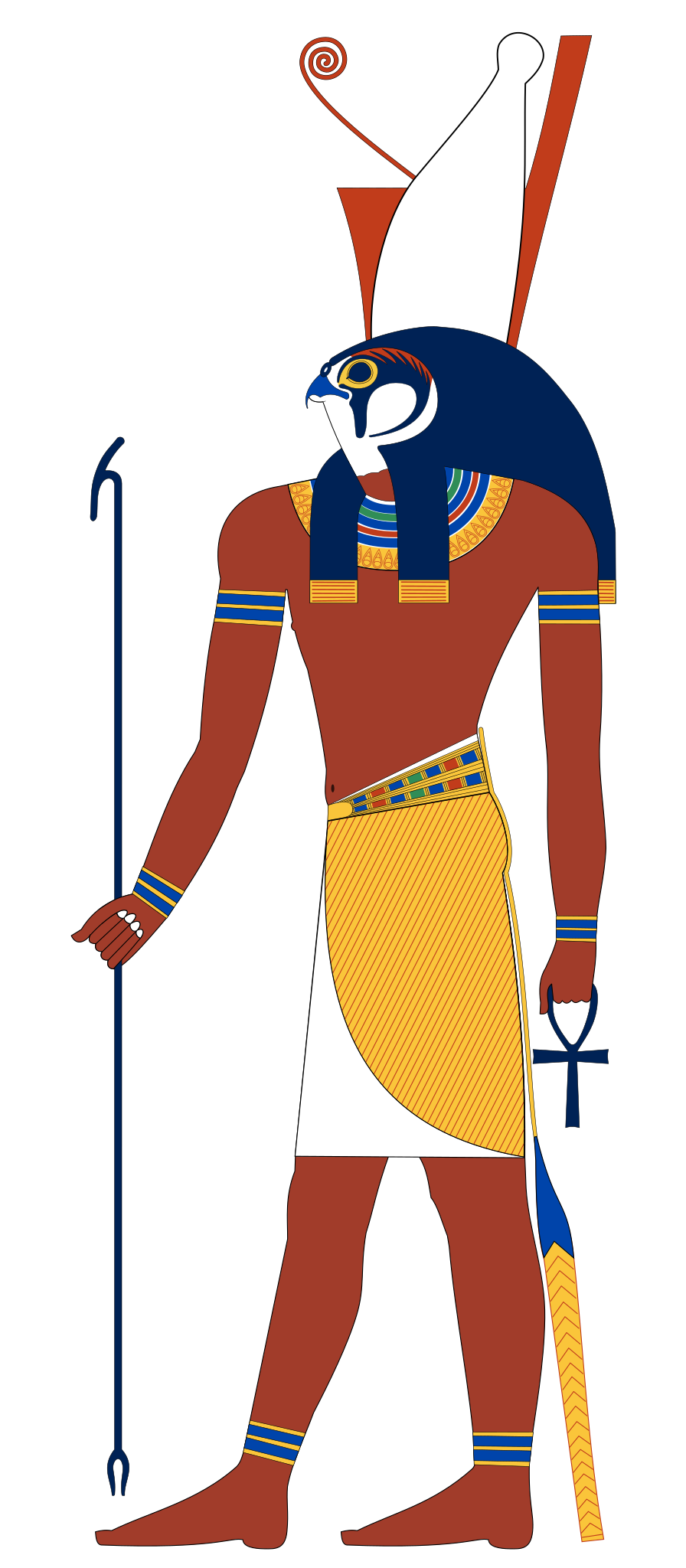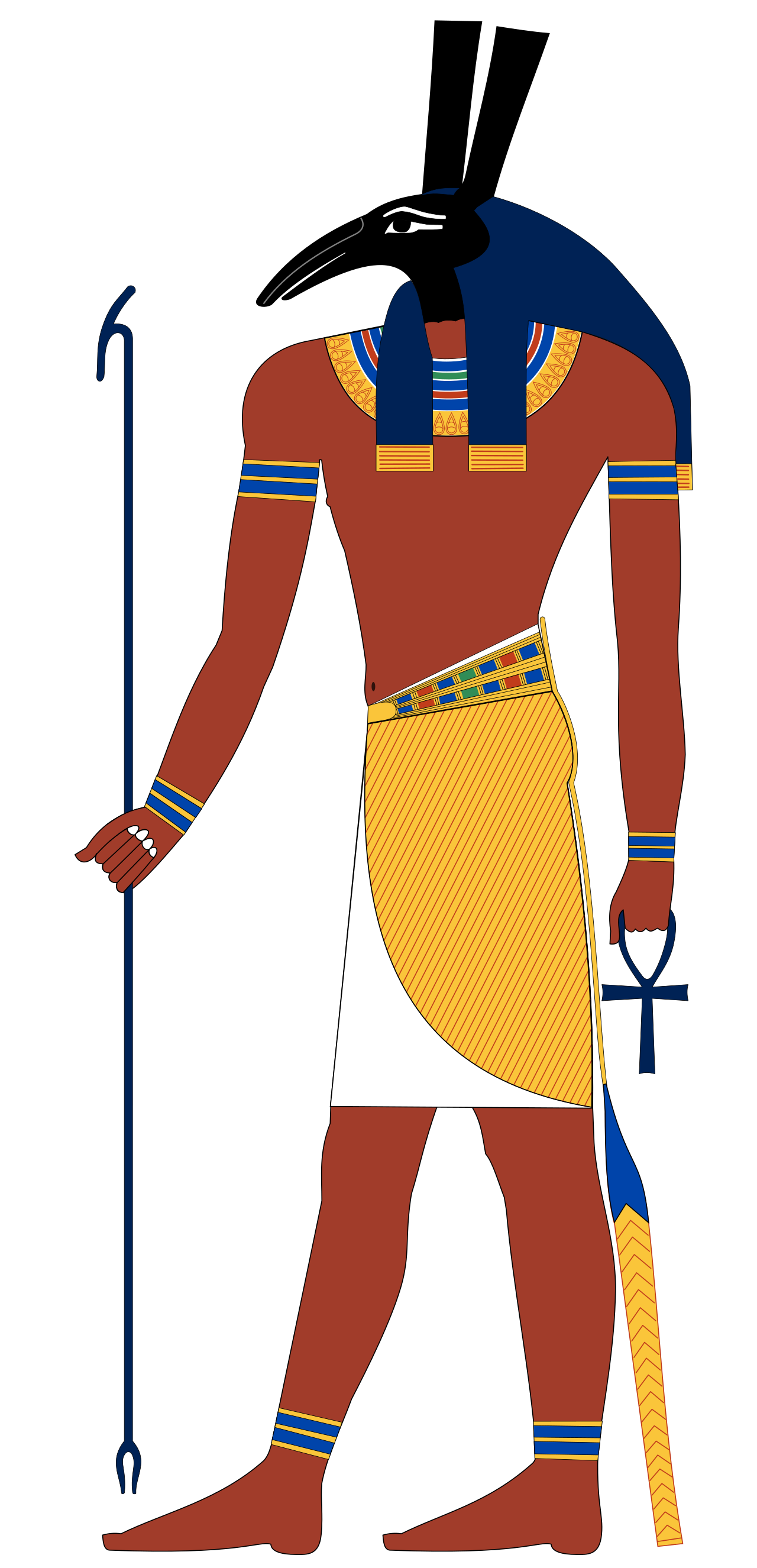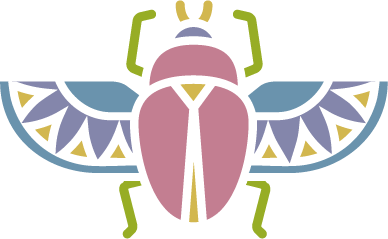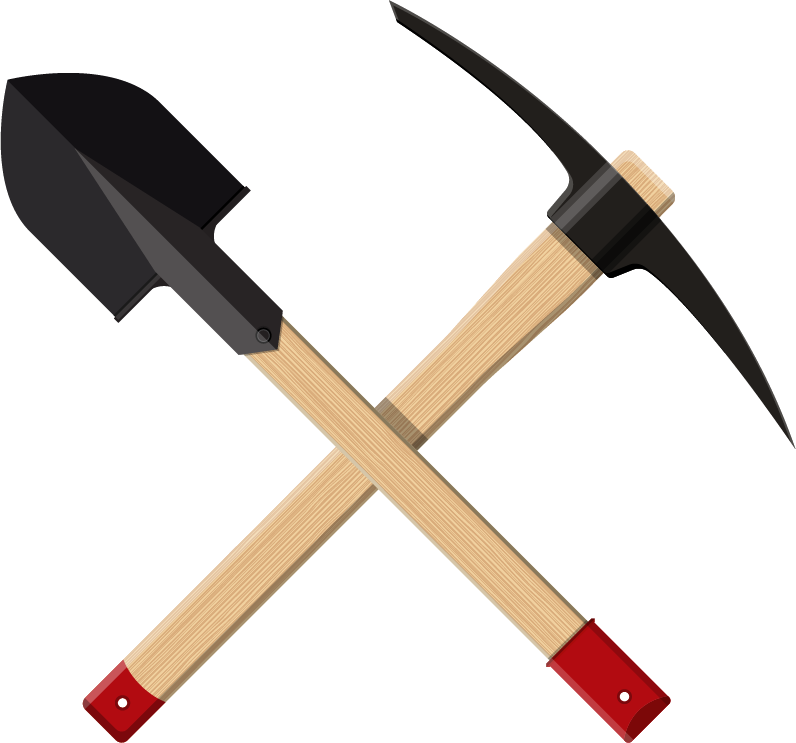Egypt: Archeology, Egyptologists, Hieroglyphics and Gods: Part 2
“A circle of rope that has no beginning and no end.”
Below: The Gods Horus and Set, Celebrating the Egyptologists and Learning About Ancient Egyptian Symbols
Horus: God of Goodness
 Horus is one of Egyptian mythology’s most ancient and significant deities, often associated with the sun, sky, and kingship. He was believed to be the god of goodness and light and was associated with protection and healing. In Egyptian mythology, Horus was considered the son of Osiris and Isis and was often depicted as a falcon or a man with a falcon head. He was believed to have the power to control the sun and was often associated with the pharaohs of Egypt, who were believed to be the embodiment of Horus on Earth. Horus was also known for his role in battles against the forces of chaos and darkness and was believed to be a powerful protector of the people. He was often depicted as a fierce warrior carrying weapons and armor. One of the most famous stories about Horus involves his battle against Set, his uncle, and the murderer of his father, Osiris. According to legend, Horus fought Set in a series of battles, ultimately defeating him and avenging his father’s death. Horus’ importance in Egyptian mythology was reflected in the many temples and shrines dedicated to him throughout Egypt. He was worshiped by common people and royalty and considered one of the most important deities in the Egyptian pantheon. [C, D]
Horus is one of Egyptian mythology’s most ancient and significant deities, often associated with the sun, sky, and kingship. He was believed to be the god of goodness and light and was associated with protection and healing. In Egyptian mythology, Horus was considered the son of Osiris and Isis and was often depicted as a falcon or a man with a falcon head. He was believed to have the power to control the sun and was often associated with the pharaohs of Egypt, who were believed to be the embodiment of Horus on Earth. Horus was also known for his role in battles against the forces of chaos and darkness and was believed to be a powerful protector of the people. He was often depicted as a fierce warrior carrying weapons and armor. One of the most famous stories about Horus involves his battle against Set, his uncle, and the murderer of his father, Osiris. According to legend, Horus fought Set in a series of battles, ultimately defeating him and avenging his father’s death. Horus’ importance in Egyptian mythology was reflected in the many temples and shrines dedicated to him throughout Egypt. He was worshiped by common people and royalty and considered one of the most important deities in the Egyptian pantheon. [C, D]
Seth: God of War
 Seth also known as Set, is one of ancient Egyptian mythology’s most complex and controversial deities. He was worshiped as the god of war, chaos, and storms and was often depicted as a fearsome creature with the head of an unknown animal. In Egyptian mythology, Seth was considered the brother and rival of Osiris and was often portrayed as a violent and aggressive deity. He was believed to have killed Osiris out of jealousy and was therefore viewed as a symbol of evil and chaos. Despite his negative reputation, Seth was also worshiped as a powerful protector of the pharaohs and the Egyptian people. He was associated with the desert, seen as a harsh and dangerous environment, and believed to have the power to repel evil spirits and protect travelers. Seth was also associated with storms and natural disasters and was believed to be able to control the winds and the weather. He was often invoked in times of drought or famine in the hopes that he would bring rain and fertility to the land. Throughout Egyptian history, Seth’s importance varied greatly. While he was sometimes vilified and demonized, he was also seen as a necessary force in the universe, helping to maintain balance and order through his opposition to the other gods. [C, D]
Seth also known as Set, is one of ancient Egyptian mythology’s most complex and controversial deities. He was worshiped as the god of war, chaos, and storms and was often depicted as a fearsome creature with the head of an unknown animal. In Egyptian mythology, Seth was considered the brother and rival of Osiris and was often portrayed as a violent and aggressive deity. He was believed to have killed Osiris out of jealousy and was therefore viewed as a symbol of evil and chaos. Despite his negative reputation, Seth was also worshiped as a powerful protector of the pharaohs and the Egyptian people. He was associated with the desert, seen as a harsh and dangerous environment, and believed to have the power to repel evil spirits and protect travelers. Seth was also associated with storms and natural disasters and was believed to be able to control the winds and the weather. He was often invoked in times of drought or famine in the hopes that he would bring rain and fertility to the land. Throughout Egyptian history, Seth’s importance varied greatly. While he was sometimes vilified and demonized, he was also seen as a necessary force in the universe, helping to maintain balance and order through his opposition to the other gods. [C, D]

Ancient Egyptian Symbols

2. The Shen—Symbol of Royalty & Symmetry
3. Wadjet (Eye of Horus)—Protection & Healing
4. The Udjat Eye (Eye of Ra)—Protection & Power
[1]![]() The Lotus symbol is considered to be a true icon in Egyptian Mythology and ancient Egyptian art. The flower a.k.a “Water lily” closes at night, sinks underwater then wakes up in the morning, that’s why it became a symbol of the sun, creation, and regeneration. The Ancient Egyptian Symbol Lotus has been associated with Atum-Ra the sun god as a giant lotus emerging from the primordial waters of Nun when the world was born and from which the sun god appeared. The cult of Osiris also used the symbol related to funeral imagery and with the deceased entering the underworld which symbolizes reincarnation. The symbol was commonly used in art to represent Upper Egypt. It was found in honored and sacred places all over Egypt, on the architecture of the capital tops of Egyptian pillars representing the Tree of Life, plus in the tombs, in Hieroglyphics, written in papyrus, found on thrones, and the headdresses of the divine pharaohs.
The Lotus symbol is considered to be a true icon in Egyptian Mythology and ancient Egyptian art. The flower a.k.a “Water lily” closes at night, sinks underwater then wakes up in the morning, that’s why it became a symbol of the sun, creation, and regeneration. The Ancient Egyptian Symbol Lotus has been associated with Atum-Ra the sun god as a giant lotus emerging from the primordial waters of Nun when the world was born and from which the sun god appeared. The cult of Osiris also used the symbol related to funeral imagery and with the deceased entering the underworld which symbolizes reincarnation. The symbol was commonly used in art to represent Upper Egypt. It was found in honored and sacred places all over Egypt, on the architecture of the capital tops of Egyptian pillars representing the Tree of Life, plus in the tombs, in Hieroglyphics, written in papyrus, found on thrones, and the headdresses of the divine pharaohs.![]() Learn more at Egypt Tours Portal.
Learn more at Egypt Tours Portal.
[2]![]() The Shen symbol is a circle of rope that has no beginning and no end, in order to form an unbroken bond that symbolizes infinity, completeness, eternity, and divine protection which made its symbol extremely popular and well–presented. The word “Shen” comes from the Ancient Egyptian word which means “Encircle”, the amulet of Shen was worn by everyone including kings. It was often linked to the Greek symbol omega which symbolizes infinity. Many deities like Horus and Isis are seen holding the Shen which made the ancient Egyptians honor the Shen as a symbol of symmetry and perfection as shown on countless personal objects, Ancient Egyptian Temples, and Ancient Egyptian Tombs.
The Shen symbol is a circle of rope that has no beginning and no end, in order to form an unbroken bond that symbolizes infinity, completeness, eternity, and divine protection which made its symbol extremely popular and well–presented. The word “Shen” comes from the Ancient Egyptian word which means “Encircle”, the amulet of Shen was worn by everyone including kings. It was often linked to the Greek symbol omega which symbolizes infinity. Many deities like Horus and Isis are seen holding the Shen which made the ancient Egyptians honor the Shen as a symbol of symmetry and perfection as shown on countless personal objects, Ancient Egyptian Temples, and Ancient Egyptian Tombs.![]() Learn more at Egypt Tours Portal.
Learn more at Egypt Tours Portal.
[3]![]() Wadjet The ancient Egyptian symbol Eye of Horus is also known as (Uto, Udjat, Wedjat) which represents healing, protection, good health, good luck, Royal power, sacrifice, and curative qualities, and is the most famous of ancient Egyptian symbols. The left eye belonged to the sky god Horus who gave it away to save his father Osiris who became the ruler of the underworld, the eye was later restored after saving the life of his father. The left eye of Horus is an ancient Egyptian symbol that represents the magical abilities and powers of the sky which were either restored by Hathor or Thoth. This symbol is extremely famous and powerful at that time as it had healing powers and was used as a medical tool to measure the ingredients while making medicine plus it was believed the eye of Horus had mathematical knowledge and power. The Eye of Horus is an incredible example of the mathematical knowledge of ancient Egyptian as the Eyes of Horus are divided into six parts and each part was given a fraction as a measurement unit. All the six-part of the eyes is associated with different sense the right side of the eye represents smell, the pupil represents sight, the left side represents hearing, the curved tail that looks like a tongue represents taste, and the teardrop represents touch.
Wadjet The ancient Egyptian symbol Eye of Horus is also known as (Uto, Udjat, Wedjat) which represents healing, protection, good health, good luck, Royal power, sacrifice, and curative qualities, and is the most famous of ancient Egyptian symbols. The left eye belonged to the sky god Horus who gave it away to save his father Osiris who became the ruler of the underworld, the eye was later restored after saving the life of his father. The left eye of Horus is an ancient Egyptian symbol that represents the magical abilities and powers of the sky which were either restored by Hathor or Thoth. This symbol is extremely famous and powerful at that time as it had healing powers and was used as a medical tool to measure the ingredients while making medicine plus it was believed the eye of Horus had mathematical knowledge and power. The Eye of Horus is an incredible example of the mathematical knowledge of ancient Egyptian as the Eyes of Horus are divided into six parts and each part was given a fraction as a measurement unit. All the six-part of the eyes is associated with different sense the right side of the eye represents smell, the pupil represents sight, the left side represents hearing, the curved tail that looks like a tongue represents taste, and the teardrop represents touch.![]() Learn more at Egypt Tours Portal.
Learn more at Egypt Tours Portal.
[4]![]() The Udjat Eye The Eye of the Ra is a famous ancient Egyptian symbol amulet capable of repelling all negative energy and creating total harmony. The origin of the symbol can be traced to a number of connected tales like the time when he sends his eye as a loving father to look for his lost children. During the absence of Ra’s original eye, another one grew. When the first eye successfully returned with the children, the eye was used as a weapon by other gods. The sun god Ra does his routine of sailing his boat across the sky during the day and then goes to the underworld at night when he was weak and vulnerable. The myth says the daughter of Ra used the power of the eye to punish the humans who ignored his instructions and laws but many gods feared the eye would destroy mankind so they capture and calmed the eyes and then returned to Ra. The symbol represents royal power & authority, regeneration, and peace. The eye of Ra is associated with the destructive power of the sun, but the Egyptians also used it to protect buildings and themselves. The amulets were painted with a dark red color and worked to protect against evil entities or spells and create good health. Another representation of the eye of Ra is the symbol of a cobra wrapped around a solar disk.
The Udjat Eye The Eye of the Ra is a famous ancient Egyptian symbol amulet capable of repelling all negative energy and creating total harmony. The origin of the symbol can be traced to a number of connected tales like the time when he sends his eye as a loving father to look for his lost children. During the absence of Ra’s original eye, another one grew. When the first eye successfully returned with the children, the eye was used as a weapon by other gods. The sun god Ra does his routine of sailing his boat across the sky during the day and then goes to the underworld at night when he was weak and vulnerable. The myth says the daughter of Ra used the power of the eye to punish the humans who ignored his instructions and laws but many gods feared the eye would destroy mankind so they capture and calmed the eyes and then returned to Ra. The symbol represents royal power & authority, regeneration, and peace. The eye of Ra is associated with the destructive power of the sun, but the Egyptians also used it to protect buildings and themselves. The amulets were painted with a dark red color and worked to protect against evil entities or spells and create good health. Another representation of the eye of Ra is the symbol of a cobra wrapped around a solar disk.![]() Learn more at Egypt Tours Portal.
Learn more at Egypt Tours Portal.
[5]![]() Hekha and Nekhakha were considered a symbol of the state’s power and the king’s absolute might and control over his subjects. The word “Hekha” is an epithet of Osiris which means “To Rule” and is considered a symbol of royal power and dominion. The symbols appear in the Early Dynastic Period during the reign of the first King Narmer (3150 BCE). The crook and the flail were first used as two emblems of the god Osiris which symbolized the authority of the Pharaohs. The Staff represents kingship, the Pharaoh is the shepherd of his people while the flail stood for the fertility of the land and the Pharaoh is the provider of food for his subjects. It was made out of wood as the ancient Egyptians believed it was scarce but the kings always used ones made of decorated gold. [D]
Hekha and Nekhakha were considered a symbol of the state’s power and the king’s absolute might and control over his subjects. The word “Hekha” is an epithet of Osiris which means “To Rule” and is considered a symbol of royal power and dominion. The symbols appear in the Early Dynastic Period during the reign of the first King Narmer (3150 BCE). The crook and the flail were first used as two emblems of the god Osiris which symbolized the authority of the Pharaohs. The Staff represents kingship, the Pharaoh is the shepherd of his people while the flail stood for the fertility of the land and the Pharaoh is the provider of food for his subjects. It was made out of wood as the ancient Egyptians believed it was scarce but the kings always used ones made of decorated gold. [D]![]() Learn more at Egypt Tours Portal.
Learn more at Egypt Tours Portal.

Celebrating the Egyptologists
 Egyptologist Belzoni, Giovanni Battista
Egyptologist Belzoni, Giovanni Battista
Belzoni, an Italian, was the strong man of Egyptology, who worked as a circus strongman in London prior to his explorations in Egypt. He was an imposing man with a height of about two meters (6ft, 6in). He was an adventurer and self taught archaeologist who possibly studied hydraulics, and who ended up working for the Egyptian vice regent, Muhammad Ali. He directed excavations, often using crude methods. However, he is credited with discovering the previously unknown upper entrance of Khafre’s pyramid at Giza. He also documented and collected antiquities.
Egyptologist Borchardt, Ludwig
A German Egyptologist and architect, Borchardt became famous for his excavations in Abusir, Abu Ghurab and Amarna (where he discovered the famous bust of Nefertiti). He made an outstanding contribution to the understanding of the architecture of the pyramid complex and founded the German Archaeological Institute in Cairo, as well as the Swiss Institute for Egyptian Archaeology and Architecture in Cairo. [A]

[A] is from a feature by Jimmy Dunn in “Tour Egypt”.
[B and D] are from Egypt Tours Portal.
[C] is from Egypt Time Travel.
[D] The artwork of the gods is by Jeff Dahl. It appears on wikipedia and is licensed under under the Creative Commons Attribution-Share Alike 4.0 International, 3.0 Unported, 2.5 Generic, 2.0 Generic and 1.0 Generic license.

